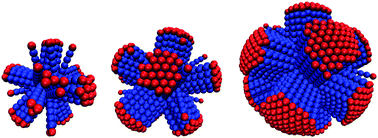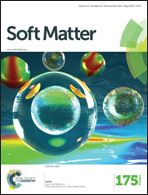Faceted particles formed by the frustrated packing of anisotropic colloids on curved surfaces
Abstract
We use computer simulations and simple theoretical models to analyze the morphologies that result when rod-like particles end-attach onto a curved surface, creating a finite-thickness monolayer aligned with the surface normal. This geometry leads to two forms of frustration, one associated with the incompatibility of hexagonal order on surfaces with Gaussian curvature, and the second reflecting the deformation of a layer with finite thickness on a surface with non-zero mean curvature. We show that the latter effect leads to a faceting mechanism. Above threshold values of inter-particle attraction strength and surface mean curvature, the adsorbed layer undergoes a transition from orientational disorder to an ordered state that is demarcated by reproducible patterns of line defects. The number of facets is controlled by the competition between line defect energy and intra-facet strain. Tuning control parameters thus leads to a rich variety of morphologies, including icosahedral particles and irregular polyhedra. In addition to suggesting a new strategy for the synthesis of aspherical particles with tunable symmetries, our results may shed light on recent experiments in which rod-like HIV GAG proteins assemble around nanoscale particles.


 Please wait while we load your content...
Please wait while we load your content...